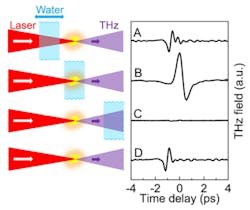Femtosecond laser pulses produce terahertz radiation from water
While terahertz radiation has been generated from solids, gases, and plasmas (the "fourth state" of matter) before, no one had created terahertz light from a liquid—until now. A group from the Institute of Optics at the University of Rochester (U of R; Rochester, NY), Huazhong University of Science and Technology (Wuhan, China), the Center for Terahertz Waves and School of Precision Instrument and Opto-electronics Engineering at Tianjin University (Tianjin, China), Capital Normal University (Beijing, China), and ITMO University (Saint Petersburg, Russia) has used the effects of femtosecond pulses on water to achieve this feat.1
"It is the first-time demonstration of intense and broadband terahertz-wave generation from liquid water," says X.-C. Zhang, professor at the U of R's Institute of Optics and one of the researchers.
In the technique, 500-fs laser pulses at a 1 kHz repetition rate and a center wavelength of 800 nm are focused onto a water film, which produces terahertz pulses of about 60 fs duration.
Because water highly absorbs terahertz radiation (with an absorption coefficient of 220 cm-1 at 1 THz), the water film must be made very thin. This is done using a gravity-driven, free-flowing setup that produces a 177-µm-thick continuous and stable vertical film of liquid water in free space.
Because a femtosecond laser focus in plain air can also generate terahertz output, the two potential outputs must be somehow separately measured. With the knowledge that water absorbs terahertz radiation, these outputs (from air and from water) can be separately measured by moving the water film axially through the laser's focal region (see figure).
At the top of the figure is shown the situation when the laser passes through the water film first and then focuses; here, a terahertz output characteristic of air is seen (similar to control setup at bottom of figure with no water film). Next, when the focus is moved to within the water film itself, the desired terahertz output from the water is seen. Finally, when the laser focuses first and then passes through the water, no terahertz output is seen due to absorption of terahertz radiation in the water.
The laser pulse energy excitation threshold to produce terahertz radiation was about 160 µJ; when the pulse energy was raised to higher than 420 µJ, the water film broke up.
The researchers believe their work will contribute both to the study of laser-liquid interactions and the creation of new terahertz sources.
REFERENCE:
1. Qi Jin et al., Applied Physics Letters 111, 071103 (2017); http://dx.doi.org/10.1063/1.4990824

John Wallace | Senior Technical Editor (1998-2022)
John Wallace was with Laser Focus World for nearly 25 years, retiring in late June 2022. He obtained a bachelor's degree in mechanical engineering and physics at Rutgers University and a master's in optical engineering at the University of Rochester. Before becoming an editor, John worked as an engineer at RCA, Exxon, Eastman Kodak, and GCA Corporation.
